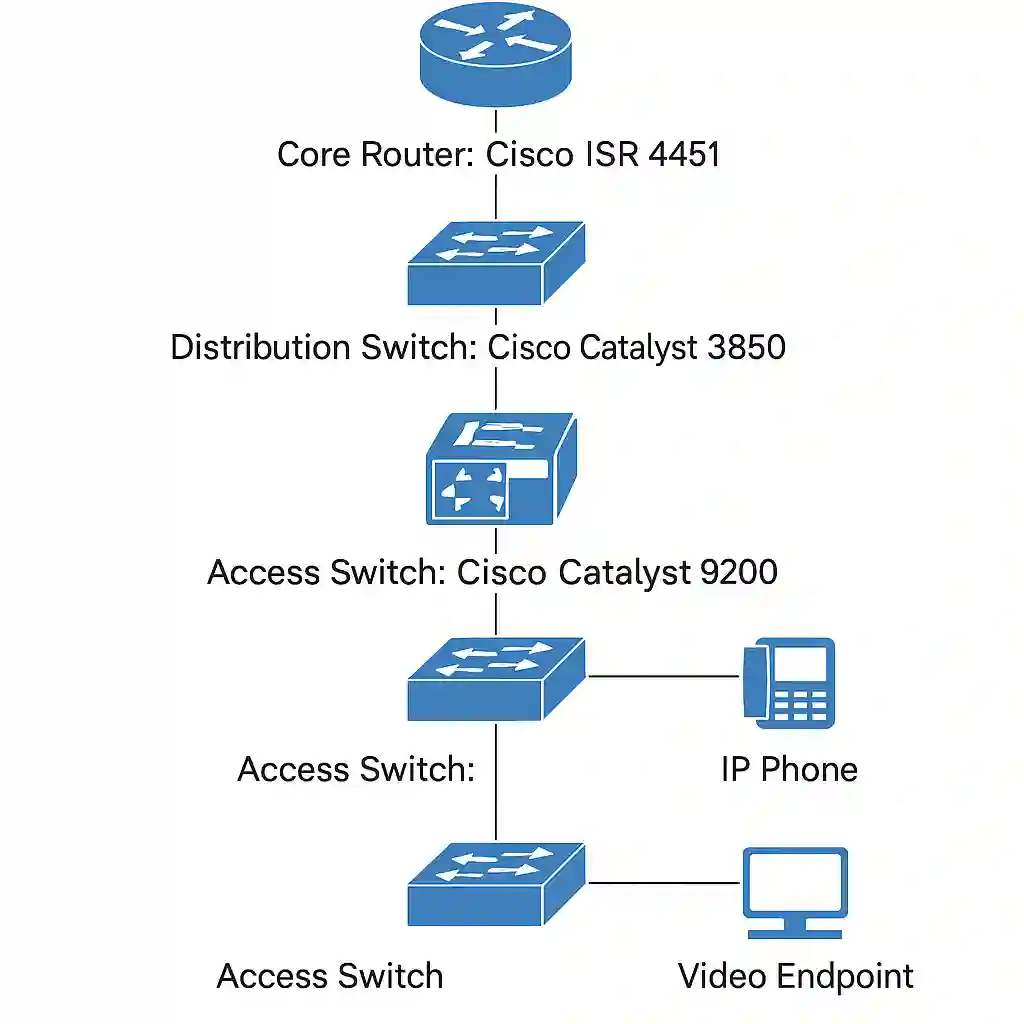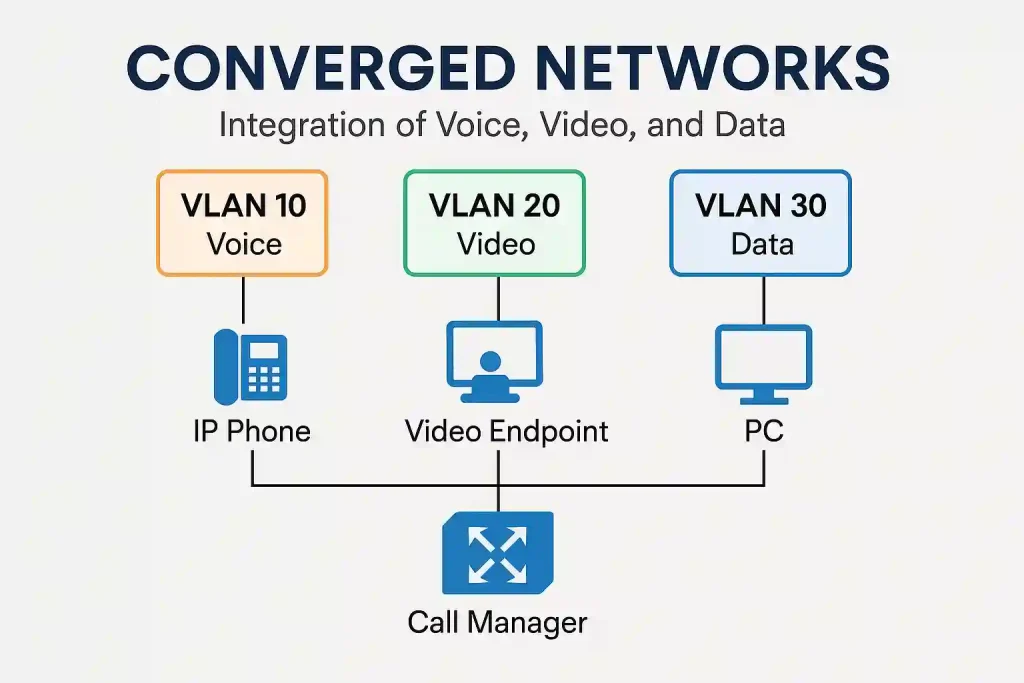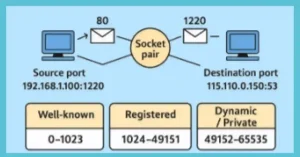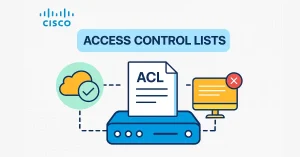A converged network integrates voice, video, and data traffic over a single, high-performance IP infrastructure, enabling efficient communication for modern businesses. Unlike traditional networks that rely on separate infrastructures for each service, a converged network leverages Layer 2 (e.g., Ethernet switches) and Layer 3 (e.g., routers) devices to streamline operations. For CCNA and CCNP students, understanding converged networks is critical, as they form the backbone of modern enterprise solutions, incorporating technologies like Cisco Unified Communications Manager (CUCM) and Quality of Service (QoS) to ensure reliable performance. This article explores the architecture, components, and benefits of converged networks, providing practical insights for Cisco certification candidates.
Components of a Converged Network
Converged networks support voice, video, and data services through a unified infrastructure, leveraging Cisco technologies and industry-standard protocols. Below are the key components, tailored for CCNA and CCNP students:
Call Management
- Functionality: Includes call processing, Caller ID, conferencing, call hold, and transfer.
- Cisco Tools: Cisco Unified Communications Manager (CUCM) handles call routing and signaling using protocols like SIP and H.323.
- CCNA/CCNP Relevance: Understand call flows and basic CUCM configuration.
Voice Messaging
- Functionality: Provides voicemail services integrated with email or softphone applications.
- Cisco Tools: Cisco Unity Connection for unified messaging.
- CCNA/CCNP Relevance: Learn to configure voicemail integration and troubleshoot connectivity.
Mobile Call Facility
- Functionality: Enables seamless mobility for users with Cisco Jabber or IP phones.
- Cisco Tools: Cisco Mobile and Remote Access (MRA) for secure external connectivity.
- CCNA/CCNP Relevance: Study VPN and firewall configurations for mobility.
Automated Attendant
- Functionality: Automates call routing with interactive voice response (IVR).
- Cisco Tools: Cisco Unified Contact Center Express (UCCX).
- CCNA/CCNP Relevance: Understand IVR scripting and integration with CUCM.
Video Conferencing
- Functionality: Supports point-to-point and multipoint video calls.
- Cisco Tools: Cisco Webex or TelePresence for high-quality video.
- CCNA/CCNP Relevance: Configure QoS to prioritize video traffic and ensure low latency.
These components rely on a robust IP network, requiring proper VLAN segmentation, QoS policies, and security measures to ensure performance and reliability.
Benefits of Converged Network
All-in-one is the primary benefit of transitioning to this type of network because there is just one physical network to install and manage all the above services. So, there are considerable savings over the installation and management of the network for the above services.
The converged network solution integrates IT management thus that any changes and additions are completed with a keen management interface. This solution also provides computer softphone application support and point-to-point video, thus that users can enjoy communications with the same ease of administration and use as a voice call.
Designing and Implementing a Converged Network
Converged networks require careful planning to handle diverse traffic types (voice, video, data) while ensuring performance, security, and scalability. Below are key design considerations for CCNA and CCNP students:
Network Architecture
- Layer 2 and Layer 3 Design: Use Cisco Catalyst switches for VLAN segmentation (e.g., separate VLANs for voice and data) and Cisco ISR routers for inter-VLAN routing and WAN connectivity.
- Topology: A hierarchical design (access, distribution, core) ensures scalability and fault tolerance. For example, access switches connect IP phones and PCs, while core routers handle high-speed routing.
Quality of Service (QoS)
- Prioritization: Implement QoS policies to prioritize voice (e.g., EF marking for VoIP) and video traffic over data.
- Cisco Tools: Use Cisco AutoQoS or manual QoS configurations on switches and routers to manage bandwidth and latency.
- CCNA/CCNP Relevance: Learn to configure QoS policies like classification, marking, and queuing.
Security
- VLAN Security: Isolate voice and data traffic using VLANs to prevent unauthorized access.
- Encryption: Use SRTP for voice and HTTPS for video to secure communications.
- Cisco Tools: Implement Cisco ISE for network access control and authentication.
Redundancy
CCNA/CCNP Relevance: Understand redundancy configurations and troubleshooting.
High Availability: Use protocols like HSRP or VRRP on Cisco routers for failover and redundant links with EtherChannel on switches.
The topology below illustrates a converged network with VLANs for voice (VLAN 10), video (VLAN 20), and data (VLAN 30), managed by CUCM for call processing.
Proper design ensures the network handles diverse traffic efficiently, a critical skill for CCNA and CCNP certification exams.

Conclusion
Converged networks represent a transformative approach to modern networking, integrating voice, video, and data over a single IP infrastructure to deliver cost-efficient, scalable, and high-performance solutions. For CCNA and CCNP students, mastering converged network concepts—such as VLAN segmentation, QoS implementation, and Cisco tools like CUCM and Catalyst switches—is essential for both certification exams and real-world applications.
By understanding the architecture, configuration, and troubleshooting of converged networks, students can build robust, secure, and efficient systems that meet enterprise demands. To deepen your knowledge, practice with Cisco Packet Tracer or GNS3, explore Cisco’s official documentation, and apply the hands-on examples provided in this article. Start building your expertise in converged networks today to excel in your Cisco certification journey and beyond.
FAQs
What is a converged network?
A converged network integrates voice, video, and data traffic over a single IP infrastructure, using Cisco technologies like CUCM and Catalyst switches to streamline operations.
Why is QoS important in a converged network?
QoS ensures low latency and high quality for time-sensitive traffic like voice and video by prioritizing packets, a key topic in CCNP exams.
What Cisco tools are used in converged networks?
Key tools include Cisco Unified Communications Manager (CUCM) for call processing, Cisco Unity Connection for voicemail, and Cisco Webex for video conferencing.
How does a converged network save costs?
By consolidating services onto one network, businesses reduce infrastructure and management costs compared to maintaining separate voice, video, and data networks.
What protocols are used for voice in converged networks?
Common protocols include SIP, H.323, and RTP, which CCNA and CCNP students must understand for configuring and troubleshooting VoIP.
How can I prepare for converged network topics in CCNA/CCNP exams?
Study VLAN configuration, QoS policies, and Cisco Unified Communications tools. Practice with Cisco Packet Tracer or GNS3 for hands-on experience.





